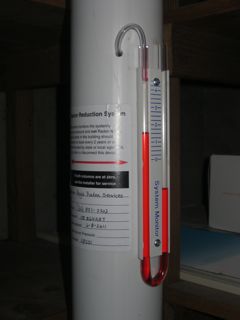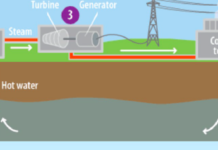Radon is a colorless, odorless, radioactive gas, and, according to the EPA, is the primary cause of lung cancer in nonsmokers, resulting in 21,000 deaths each year. Now, a report by the Institute of Medicine, suggests efforts to make homes more energy efficient may be increasing radon concentrations.

The Institute of Medicine report, issued June 7th, warns that weatherizing a home could result in increased radon concentration due to the decreased ventilation. According to the report, “The only important mechanism for removing radon from indoor air is ventilation.”
Radon enters homes through the slow decay of radium in the soil. Radium decays with a half-life of 1,600 years into radon through the release an alpha particle. This means that half of a sample of radium will decay into radon gas every 1,600 years. The radon itself is not dangerous to humans, but it rapidly decays, at a half-life of about 4 days, into bismuth, lead and polonium. These elements react with lung tissues and can result in cancer, according to the Institute of Medicine report.
Radon collects in some homes as a result of the “stack effect.” Low pressure in a home creates a vacuum effect that “sucks up” radon gas from the soil through the cracks and pores in the foundation.
According to Bob Dye, environmental scientist with the EPA, this effect is especially prominent during the winter. “One, the house is closed up, and two, in the wintertime the furnace is running, as it's drawing air it sucks radon in the home. Warm air rises, reduces pressure and more radon can get in from the soil,” Dye explains to SciJourner.
Radon concentration is measured in units of picocuries per liter (pCi/L), and the EPA recommends that houses with a concentration above 4 pCi/L be fixed. At this concentration, the EPA claims that of 1,000 people exposed over a lifetime, about 7 nonsmoker deaths would result. The average outdoor radon concentration is 0.4 pCi/L.
Mike Goodson, president of Aegis Radon Services, a company that mitigates radon in the St. Louis area, says that 25% of homes in the St. Louis metro area have a level of radon above 4 pCi/L. But he's seen a house in Ballwin, MO as high as 290 pCi/L. "That's the only home we've ever been nervous in a in a short-term setting," Goodson tells SciJourner.
The methods for fixing a home with radon depend on the structure. Depressurization is the most common approach. This involves pulling air with radon from underneath the slab of a home, and pumping it out above ground. As long as the pressure below the slab is lower than the vacuum created by the home, the radon concentration decreases. “Depressurization is the most efficient in cost over the long run,” Goodson says. “You're paying $30 per year for the fan and power.”
The national average for radon mitigation is about $1,100, according to Goodson, but in St. Louis it costs around $650-$850. He attributes this difference to lack of oversight by the state of Missouri.

“A guy who comes in low on price, in some cases, uses inferior materials,” argues Goodson. “What states have done is they form an organization that understands record keeping, they understand what the standards are, and they spot-check sites. That eventually raises prices, but it levels the playing field in terms of prices.”
According to a December 2009 report issued by the University of Kentucky[PDF], 18 states including Illinois and Iowa, require radon professionals to be certified. Missouri does not. The report also cautions, “By proposing weak, ineffective or no radon policies, opponents perpetuate the myth that radon is not really harmful.”
Dye recommends that anyone who has an elevated level of radon use a certified mitigation specialist. “The EPA runs a voluntary program for testers and mitigators. [Certification] helps provide better assurance to the public that the people testing and fixing your home have quality assurance,” says Dye, who’s worked 26 years for the EPA.
The Missouri Department of Health & Senior services did not return phone calls from SciJourner. They do, however, offer a free radon test kit to residents of Missouri and links to certified mitigation specialists at http://health.mo.gov/living/environment/radon/.
Goodson added, “I think there's a lot of myths regarding what home can have radon. It's important for the public to understand that no matter what myth is out there, the EPA recommends every structure be tested, because we've had homes where you would not assume there'd be a high level, and there it is.”

This work is licensed under a Creative Commons Attribution-NonCommercial-NoDerivs 3.0 Unported License














It is terrifying that 25% of homes in the Missouri area have dangerous levels of radon. Every legislator in Illinois should read this article and pass some legislation. This is absolutely a huge public health issue, which can save thousands of dollars (and lives) if causes are mitigated.
Thanks for your comment Bryce. I hope awareness is raised such that residents at least take advantage of the free test kit offered by the state I have one going in my home right now. It’s very easy.
It is even more serious if your home is contaminated and you have children with lower level such as basement bedrooms. They are more prone to lung cancer because their body is still growing and has high level of cell division. However, I read somewhere that by the time it reaches the first floor of the house it has broken down, only last less than 5 minutes as radon.
Great article has all the right information about radioactivity
I learn from you in very strange ways but they are awesome, but I just want to let you know that I never new that radon even existed. So I would like to thank you for helping me with knowing what radon is and all of the hazards that this can cause to a human. So when I get home I will tell my dad to get our house checked out for radon.:cried:congrate